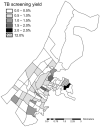A role for community-level socioeconomic indicators in targeting tuberculosis screening interventions
- PMID: 35039612
- PMCID: PMC8764089
- DOI: 10.1038/s41598-022-04834-7
A role for community-level socioeconomic indicators in targeting tuberculosis screening interventions
Abstract
Tuberculosis screening programs commonly target areas with high case notification rates. However, this may exacerbate disparities by excluding areas that already face barriers to accessing diagnostic services. We compared historic case notification rates, demographic, and socioeconomic indicators as predictors of neighborhood-level tuberculosis screening yield during a mobile screening program in 74 neighborhoods in Lima, Peru. We used logistic regression and Classification and Regression Tree (CART) analysis to identify predictors of screening yield. During February 7, 2019-February 6, 2020, the program screened 29,619 people and diagnosed 147 tuberculosis cases. Historic case notification rate was not associated with screening yield in any analysis. In regression analysis, screening yield decreased as the percent of vehicle ownership increased (odds ratio [OR]: 0.76 per 10% increase in vehicle ownership; 95% confidence interval [CI]: 0.58-0.99). CART analysis identified the percent of blender ownership (≤ 83.1% vs > 83.1%; OR: 1.7; 95% CI: 1.2-2.6) and the percent of TB patients with a prior tuberculosis episode (> 10.6% vs ≤ 10.6%; OR: 3.6; 95% CI: 1.0-12.7) as optimal predictors of screening yield. Overall, socioeconomic indicators were better predictors of tuberculosis screening yield than historic case notification rates. Considering community-level socioeconomic characteristics could help identify high-yield locations for screening interventions.
© 2022. The Author(s).
Conflict of interest statement
The authors declare no competing interests.
Figures



Similar articles
-
Geographic accessibility to health facilities predicts uptake of community-based tuberculosis screening in an urban setting.Int J Infect Dis. 2022 Jul;120:125-131. doi: 10.1016/j.ijid.2022.04.031. Epub 2022 Apr 22. Int J Infect Dis. 2022. PMID: 35470023 Free PMC article.
-
Evaluation of a tuberculosis active case finding project in peri-urban areas, Myanmar: 2014-2016.Int J Infect Dis. 2018 May;70:93-100. doi: 10.1016/j.ijid.2018.02.012. Epub 2018 Feb 21. Int J Infect Dis. 2018. PMID: 29476901
-
Spatial distribution of people diagnosed with tuberculosis through routine and active case finding: a community-based study in Kampala, Uganda.Infect Dis Poverty. 2020 Jun 22;9(1):73. doi: 10.1186/s40249-020-00687-2. Infect Dis Poverty. 2020. PMID: 32571435 Free PMC article.
-
Requiring smartphone ownership for mHealth interventions: who could be left out?BMC Public Health. 2020 Jan 20;20(1):81. doi: 10.1186/s12889-019-7892-9. BMC Public Health. 2020. PMID: 31959145 Free PMC article.
-
Hyperendemic pulmonary tuberculosis in a Peruvian shantytown.Am J Epidemiol. 1998 Aug 15;148(4):384-9. doi: 10.1093/oxfordjournals.aje.a009657. Am J Epidemiol. 1998. PMID: 9717883
Cited by
-
Neighbourhood prevalence-to-notification ratios for adult bacteriologically-confirmed tuberculosis reveals hotspots of underdiagnosis in Blantyre, Malawi.PLoS One. 2022 May 23;17(5):e0268749. doi: 10.1371/journal.pone.0268749. eCollection 2022. PLoS One. 2022. PMID: 35605004 Free PMC article.
-
Who Transmits Tuberculosis to Whom: A Cross-Sectional Analysis of a Cohort Study in Lima, Peru.Am J Respir Crit Care Med. 2024 Jul 15;210(2):222-233. doi: 10.1164/rccm.202307-1217OC. Am J Respir Crit Care Med. 2024. PMID: 38416532 Free PMC article.
-
Geospatial analysis of reported activity locations to identify sites for tuberculosis screening.Sci Rep. 2022 Aug 18;12(1):14094. doi: 10.1038/s41598-022-18456-6. Sci Rep. 2022. PMID: 35982104 Free PMC article.
References
-
- WHO, Global Tuberculosis Report, 2020. (World Health Organization, 2020).
Publication types
MeSH terms
Grants and funding
LinkOut - more resources
Full Text Sources
Medical

